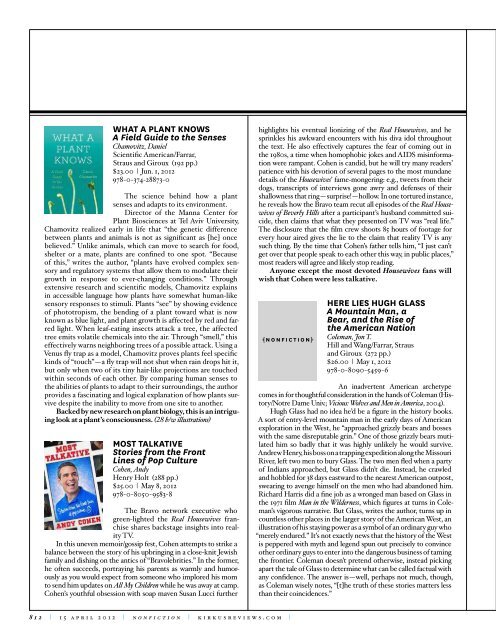nonfiction
nonfiction
nonfiction
Create successful ePaper yourself
Turn your PDF publications into a flip-book with our unique Google optimized e-Paper software.
“A fluid study of how<br />
heavy-handed repression by authoritarian regimes<br />
has given way to more subtle forms of control.”<br />
from the dictator’s learning curve<br />
WHAT A PLANT KNOWS<br />
A Field Guide to the Senses<br />
Chamovitz, Daniel<br />
Scientific American/Farrar,<br />
Straus and Giroux (192 pp.)<br />
$23.00 | Jun. 1, 2012<br />
978-0-374-28873-0<br />
The science behind how a plant<br />
senses and adapts to its environment.<br />
Director of the Manna Center for<br />
Plant Biosciences at Tel Aviv University,<br />
Chamovitz realized early in life that “the genetic difference<br />
between plants and animals is not as significant as [he] once<br />
believed.” Unlike animals, which can move to search for food,<br />
shelter or a mate, plants are confined to one spot. “Because<br />
of this,” writes the author, “plants have evolved complex sensory<br />
and regulatory systems that allow them to modulate their<br />
growth in response to ever-changing conditions.” Through<br />
extensive research and scientific models, Chamovitz explains<br />
in accessible language how plants have somewhat human-like<br />
sensory responses to stimuli. Plants “see” by showing evidence<br />
of phototropism, the bending of a plant toward what is now<br />
known as blue light, and plant growth is affected by red and farred<br />
light. When leaf-eating insects attack a tree, the affected<br />
tree emits volatile chemicals into the air. Through “smell,” this<br />
effectively warns neighboring trees of a possible attack. Using a<br />
Venus fly trap as a model, Chamovitz proves plants feel specific<br />
kinds of “touch”—a fly trap will not shut when rain drops hit it,<br />
but only when two of its tiny hair-like projections are touched<br />
within seconds of each other. By comparing human senses to<br />
the abilities of plants to adapt to their surroundings, the author<br />
provides a fascinating and logical explanation of how plants survive<br />
despite the inability to move from one site to another.<br />
Backed by new research on plant biology, this is an intriguing<br />
look at a plant’s consciousness. (28 b/w illustrations)<br />
MOST TALKATIVE<br />
Stories from the Front<br />
Lines of Pop Culture<br />
Cohen, Andy<br />
Henry Holt (288 pp.)<br />
$25.00 | May 8, 2012<br />
978-0-8050-9583-8<br />
The Bravo network executive who<br />
green-lighted the Real Housewives franchise<br />
shares backstage insights into reality<br />
TV.<br />
In this uneven memoir/gossip fest, Cohen attempts to strike a<br />
balance between the story of his upbringing in a close-knit Jewish<br />
family and dishing on the antics of “Bravolebrities.” In the former,<br />
he often succeeds, portraying his parents as warmly and humorously<br />
as you would expect from someone who implored his mom<br />
to send him updates on All My Children while he was away at camp.<br />
Cohen’s youthful obsession with soap maven Susan Lucci further<br />
highlights his eventual lionizing of the Real Housewives, and he<br />
sprinkles his awkward encounters with his diva idol throughout<br />
the text. He also effectively captures the fear of coming out in<br />
the 1980s, a time when homophobic jokes and AIDS misinformation<br />
were rampant. Cohen is candid, but he will try many readers’<br />
patience with his devotion of several pages to the most mundane<br />
details of the Housewives’ fame-mongering: e.g., tweets from their<br />
dogs, transcripts of interviews gone awry and defenses of their<br />
shallowness that ring—surprise!—hollow. In one tortured instance,<br />
he reveals how the Bravo team recut all episodes of the Real Housewives<br />
of Beverly Hills after a participant’s husband committed suicide,<br />
then claims that what they presented on TV was “real life.”<br />
The disclosure that the film crew shoots 85 hours of footage for<br />
every hour aired gives the lie to the claim that reality TV is any<br />
such thing. By the time that Cohen’s father tells him, “I just can’t<br />
get over that people speak to each other this way, in public places,”<br />
most readers will agree and likely stop reading.<br />
Anyone except the most devoted Housewives fans will<br />
wish that Cohen were less talkative.<br />
HERE LIES HUGH GLASS<br />
A Mountain Man, a<br />
Bear, and the Rise of<br />
the American Nation<br />
Coleman, Jon T.<br />
Hill and Wang/Farrar, Straus<br />
and Giroux (272 pp.)<br />
$26.00 | May 1, 2012<br />
978-0-8090-5459-6<br />
An inadvertent American archetype<br />
comes in for thoughtful consideration in the hands of Coleman (History/Notre<br />
Dame Univ.; Vicious: Wolves and Men in America, 2004).<br />
Hugh Glass had no idea he’d be a figure in the history books.<br />
A sort of entry-level mountain man in the early days of American<br />
exploration in the West, he “approached grizzly bears and bosses<br />
with the same disreputable grin.” One of those grizzly bears mutilated<br />
him so badly that it was highly unlikely he would survive.<br />
Andrew Henry, his boss on a trapping expedition along the Missouri<br />
River, left two men to bury Glass. The two men fled when a party<br />
of Indians approached, but Glass didn’t die. Instead, he crawled<br />
and hobbled for 38 days eastward to the nearest American outpost,<br />
swearing to avenge himself on the men who had abandoned him.<br />
Richard Harris did a fine job as a wronged man based on Glass in<br />
the 1971 film Man in the Wilderness, which figures at turns in Coleman’s<br />
vigorous narrative. But Glass, writes the author, turns up in<br />
countless other places in the larger story of the American West, an<br />
illustration of his staying power as a symbol of an ordinary guy who<br />
“merely endured.” It’s not exactly news that the history of the West<br />
is peppered with myth and legend spun out precisely to convince<br />
other ordinary guys to enter into the dangerous business of taming<br />
the frontier. Coleman doesn’t pretend otherwise, instead picking<br />
apart the tale of Glass to determine what can be called factual with<br />
any confidence. The answer is—well, perhaps not much, though,<br />
as Coleman wisely notes, “[t]he truth of these stories matters less<br />
than their coincidences.”<br />
Good storytelling matched with appropriate historical<br />
skepticism—a useful model for examining other 10-gallon<br />
yarns of westward expansion.<br />
DIAMOND IN THE ROUGH<br />
A Memoir<br />
Colvin, Shawn<br />
Morrow/HarperCollins (256 pp.)<br />
$25.99 | $12.99 e-book | Jun. 5, 2012<br />
978-0-06-175959-8<br />
978-0-06-209916-7 e-book<br />
A chatty, but only occasionally enlightening,<br />
life story from the confessional<br />
singer-songwriter.<br />
Three-time Grammy winner Colvin’s<br />
life has long been a source for her songs, but it wears thin in her<br />
memoir. She’s frank about the many ups and downs of her personal<br />
life and career, where the slow climb to commercial and critical<br />
success meant overcoming a series of personal disasters: alcoholism,<br />
anorexia, clinical depression, panic disorder and numerous<br />
broken romances. In perspective, it’s an inspiring story, as Colvin<br />
spent years of paying dues and saw her first album, Steady On, win<br />
a Grammy. She has overcome a lot, and is apparently content with<br />
her life as a respected singer and devoted mother. Unfortunately,<br />
the book too often bogs down into the territory of many numbing<br />
addiction chronicles, padded with daily affirmations, mad<br />
shopping binges and the usual dreary details of life on the road. At<br />
times, the book feels like a therapeutic chore. For patient readers<br />
and close listeners of her music, there is some payoff when Colvin<br />
discusses her songs and the writing process: how “Diamond in<br />
the Rough” put her in the odd position of co-writing “a song with<br />
someone about breaking up with that someone” or how “if you<br />
can get one good line or verse right at the beginning, the song will<br />
be set up well for you.” Also: “the act of performing a new song in<br />
front of people is the ultimate bullshit detector.”<br />
Ultimately, there’s too much “Of Meds and Men” and<br />
too little of the music that made Colvin popular. (B/W photos<br />
throughout. Author appearances in Austin and New York)<br />
BAG OF BONES<br />
The Sensational Grave<br />
Robbery of the Merchant<br />
Prince of Manhattan<br />
Conway, J. North<br />
Lyons Press (320 pp.)<br />
$24.95 | May 1, 2012<br />
978-0-7627-7812-6<br />
The final installment of the author’s<br />
true-crime trilogy about New York City<br />
in the Gilded Age.<br />
Conway (The Big Policeman: The Rise and Fall of America’s First,<br />
Most Ruthless, and Greatest Detective, 2010, etc.) tells the story of<br />
the life and death of “The Merchant Prince of Manhattan,” A.T.<br />
Stewart, the father of the American department store, who was,<br />
at the time of his death, the third richest man in the United<br />
States (behind William Astor Sr. and Cornelius Vanderbilt). A<br />
hard-working Irish immigrant, Stewart eventually grew his<br />
fortune to $40 million but was never accepted by New York’s<br />
elite—despite two landmark retail outlets and his massive Italian<br />
marble mansion, “considered one of the most ornate and<br />
elaborate private homes in America.” Two years after his death<br />
in 1876, his body was stolen from the family crypt. “Not only did<br />
the grave robbing cause a national sensation,” writes Conway,<br />
“it also led to one of the most notoriously bungled police investigations<br />
in New York City’s history.” Judge Henry Hilton, Stewart’s<br />
friend, was directed to sell off Stewart’s businesses, but he<br />
ran them into the ground within six years. Eventually Stewart’s<br />
wife exchanged $20,000 for a bag of bones she hoped were her<br />
husband’s. Hilton also impeded the police investigation, which<br />
never got off the ground, and may have committed fraud in the<br />
form of Cornelia’s will, which named him as a significant benefactor.<br />
In support of his story, Conway uses numerous headlines<br />
and portions of articles from newspapers of the era. The device<br />
is occasionally clunky and leads to a repetitive, though generally<br />
engrossing, narrative.<br />
A quick read about a gruesome crime with a twist at the<br />
end—will appeal mostly to die-hard fans of historical true crime.<br />
THE DICTATOR’S<br />
LEARNING CURVE<br />
Inside the Global<br />
Battle for Democracy<br />
Dobson, William J.<br />
Doubleday (352 pp.)<br />
$28.95 | Jun. 5, 2012<br />
978-0-385-53335-5<br />
A fluid study of how heavy-handed<br />
repression by authoritarian regimes has<br />
given way to more subtle forms of control.<br />
Despite some reassuring advances in democracy over the<br />
last 40 years, from the collapse of dictatorships in Latin America,<br />
East Asia, Africa, Eastern Europe and recent progress since<br />
last year’s Arab Spring, Slate foreign affairs editor Dobson sees<br />
a pernicious, no-less-repressive shift in the tactics of autocrats<br />
still hanging on. Old-style authoritarian regimes have given way<br />
to modern dictators who “work in the more ambiguous spectrum<br />
that exists between democracy and authoritarianism”—<br />
e.g., in Russia and China. In chapters that treat the newfangled<br />
dictatorial styles of these leaders (e.g., “The Czar” refers to<br />
Vladimir Putin; “The Pharaoh” to Hosni Mubarak) alternating<br />
with chapters on the increasingly savvy forces working against<br />
them (“The Opposition” and “The Youth”), Dobson travels<br />
around the globe, from Malaysia to Venezuela, chronicling his<br />
encounters with both camps. The tools of the dictator have<br />
always involved centralization of power, and for the modern<br />
autocrat no less, especially control of TV and newspapers. They<br />
are also more careful now not to upset the sense of political<br />
apathy, “the grease that helps any authoritarian system hum.”<br />
812 | 15 april 2012 | <strong>nonfiction</strong> | kirkusreviews.com |<br />
| kirkusreviews.com | <strong>nonfiction</strong> | 15 april 2012 | 813






